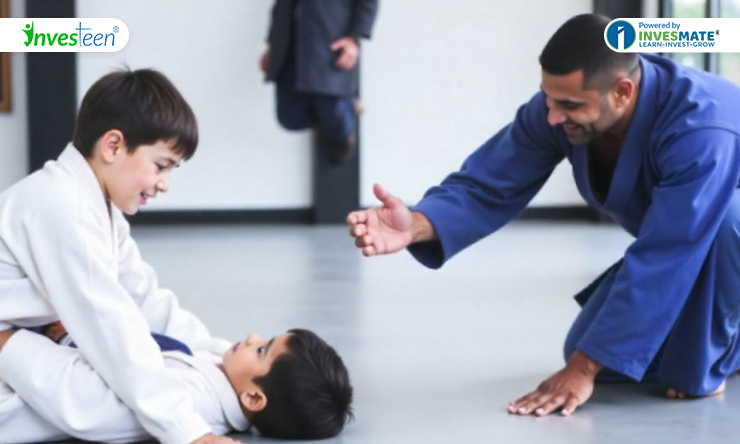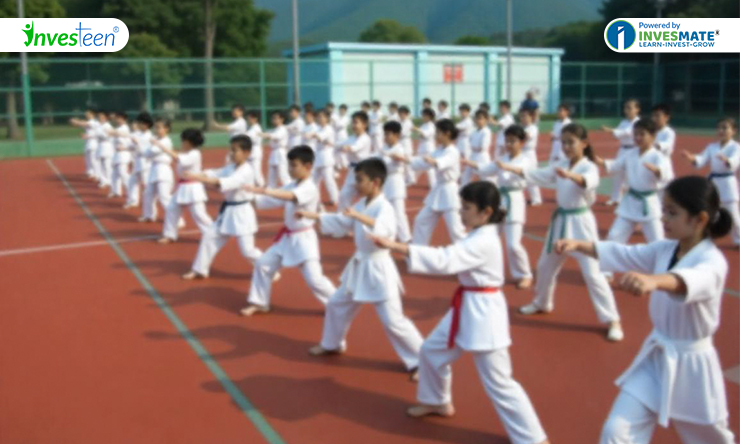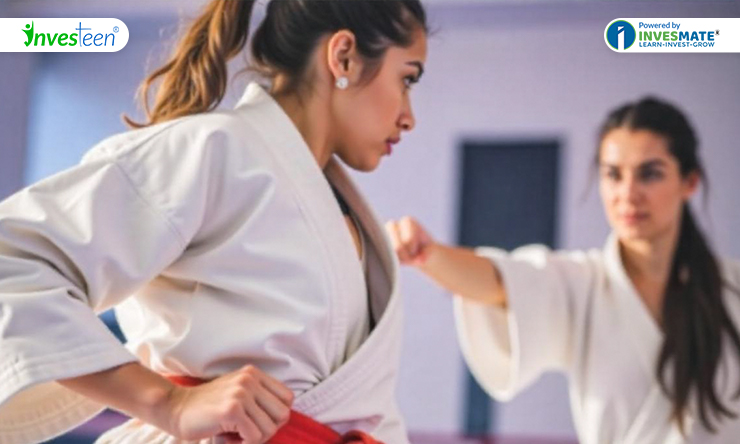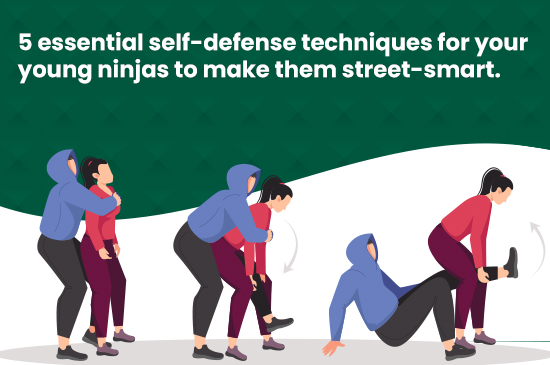Introduction
Imagine this, Your teen is walking home from school, headphones in, lost in their thoughts. Suddenly, an unfamiliar presence looms nearby. Would they know what to do?
As parents, it’s natural to worry about your child’s safety in a world full of uncertainties. While you can’t always be by their side, there’s one way to ease your worries. Empower your young ninja with essential self-defense skills that not only protect them physically but also build their confidence and mental resilience.
This blog isn’t just about teaching kicks and punches—it’s about instilling awareness, quick thinking, and self-assurance in your teen. Dive in to discover 5 practical self-defense techniques that will transform your child’s journey into the world into one of courage and safety. Let’s equip them with the tools to face the world head-on, one move at a time.
Are you worried as a parent for your little ones? Then we can promise you that we will transform your worries into assurance by discussing the importance of learning self-defense and 5 specific self-defense techniques and martial arts tactics that you can instruct your children to safeguard them from danger approaching in the outer world.
The importance of self-defense for teenagers in today's world

In today’s fast-paced and unpredictable world, self-defense isn’t just a skill—it’s a necessity. Teenagers, in particular, are at a vulnerable stage where they face new environments and situations daily. Teaching them self-defense not only enhances their safety but also fosters resilience, confidence, and independence. The ability to defend oneself not only promotes safety but also boosts self-esteem and prepares teens for unexpected scenarios.
1. The Concept of Situational Awareness

self-defense begins with awareness. Recognizing and avoiding potential threats can prevent the majority of dangerous situations. Teens must learn to stay vigilant and assess their surroundings effectively, minimizing the risk of harm before it escalates. This knowledge not only promotes self-defense techniques but also improves people’s security and self-esteem.
2. Tips to Stay Alert in Different Situations

- Stay Off Your Phone: In the case of walking or public areas, it is recommended to hide the cell phone. This helps maintain focus on your surroundings.
- Use Your Senses: Pay attention to what you see, hear, and feel. Pay attention to abnormal sounds and movements that may signal a hazard.
- Trust Your Instincts: If something feels off, act accordingly. and avoid an area that could be hazardous.
- Walk with Purpose: Maintain a confident posture and walk briskly to discourage potential attackers. It is more probable for them to try to move toward an exploitable position or to pretend that it will be as distracting as possible when it is really dangerous.
- Know escape routes: Be familiar with the exits and safe zones in any setting, like during school, in a grocery store, or in the street.
3. Tips to Stay Alert in Different Situations
- Stay Off Your Phone: In the case of walking or public areas, it is recommended to hide the cell phone. This helps maintain focus on your surroundings.
- Use Your Senses: Pay attention to what you see, hear, and feel. Pay attention to abnormal sounds and movements that may signal a hazard.
- Trust Your Instincts: If something feels off, act accordingly. and avoid an area that could be hazardous.
- Walk with Purpose: Maintain a confident posture and walk briskly to discourage potential attackers. It is more probable for them to try to move toward an exploitable position or to pretend that it will be as distracting as possible when it is really dangerous.
- Know escape routes: Be familiar with the exits and safe zones in any setting, like during school, in a grocery store, or in the street.
Mental Preparedness

The importance of a strong mindset
The mindset is just as important as physical techniques in self-defense. When teens learn to stay calm and focused under pressure, they’re more likely to react effectively in dangerous situations. Learning what is the most effective way to defend yourself keeps teens more confident and safer in their daily activities.
Building Confidence and Assertiveness:
- Self-defense training fosters self-esteem & self-confidence and prepares teens to handle threats with assurance.
- Setting personal boundaries allows teens to assert themselves and communicate their limits.
- Positive affirmations can build a sense of self-efficacy, which helps teens feel empowered to speak up and defend themselves.
Basic Self-Defense Moves Every Teen Should Know

These five techniques are simple yet effective ways for teens to defend themselves in various situations.
1. Hammer Fist Strike
The hammer fist is a strong and effective self-defense technique that can help a teen protect themselves from an attacker.
How to perform
- Make a fist with your dominant hand.
- Target vulnerable areas like the nose, jaw, or temple.
- Swing your fist downwards with force, using your body weight for extra impact.
This move is effective for creating an opportunity to escape from a dangerous situation.
2. Escape from a Headlock
What it is:
Being caught in a headlock can be terrifying. Knowing how to break free can save a teen from a dangerous situation.
Steps to Escape:
- Tuck your chin to protect your throat.
- Drop your weight and move slightly forward.
- Strike the attacker’s groin with your free arm.
- Pivot to the side, making your escape.
This technique helps the teen regain control and create space for the attacker.
3. Knee Strike
A knee strike is a quick and most effective way to defend yourself and disable an attacker.
How to execute:
- If grabbed or approached directly, lift your knee sharply into the attacker’s groin.
- This move targets a sensitive area and can inflict significant pain, giving the teen a chance to get away.
- Knee strikes are straightforward yet powerful in close-range encounters.
4. Elbow Strike
Using elbows can often be more effective than punches as self-defense techniques for beginners due to their strength and close range.
- If an attacker is nearby, swing your elbow into their face or jaw.
- This strike can disorient the attacker, allowing for a quick getaway.
- Elbow strikes are strong and can be delivered swiftly when necessary.
5. Awareness and De-escalation Techniques
Although it is the basis for any conflict, the ability to identify and cope with an aversive contingency is not far less important in the context of the avoidance of conflict.
- During social contact, verbal de-escalation behaviors, such as remaining calm and speaking in a self-assured way, should be utilized.
- By teaching adolescents how they can identify and avoid a variety of dangers, it is possible to stop the vast majority of adverse occurrences from becoming worse.
- When endangered, make noise and try to let the maximum people know about the threat.
The Benefits of Martial Arts for Self-Defense

If asked, “What is the most effective form of self-defense” then undoubtedly one answer comes in front which is martial arts. Martial arts training has the following protective effects on adolescent self-defense. Here are some key benefits:
Practical self-defense Skills: Certain effective methods can be utilized in the daily life of Martial arts particularly for women’s self-defense methods. The abilities covered students can respond to simple attacks to sophisticated evasions are taught and prepared to handle one of several types of attacks. As an example, the art of close-quarter fighting on the ground is defined and pursued with Brazilian Jiu-Jitsu, and the deadly close-quarter fighting against an attacker armed with weapons is defined and pursued by Krav Maga.
Improved Physical Fitness: Physical training has been an outcome of martial arts training using methods leading to increased physical fitness, range of motion, and responsiveness. This high-grade physical fitness is also a good asset for the implementation of self-defense methods, but at the same time, it has some positive effects on physical health and quality of life.
- Increased Confidence: Education on how to defend oneself leads to self-efficacy and self-esteem. With age the teenager develops skill in proficient martial arts, and, as a consequence, appears more capable of defending himself against a potential attacker, so there is less likelihood of such an attempt.
Self-Defense Classes: Why They Matter
Structured self-defense classes offer teens a safe and supportive environment to learn critical skills.
Benefits of Self-Defense Classes:
- Realistic Scenarios: Classes simulate real-world situations, helping teens prepare for anything that may arise.
- Structured Learning: provides a clear and safe approach to learning self-defense A certified instructor.
- Community Support: Classes foster a sense of belonging, where teens learn in a group setting and motivate each other.
How to Choose the Right Self-Defense Instructor
The right instructor can make all the difference. When selecting a self-defense program, consider these tips:
- Check credentials: Ensure the instructor is certified in self-defense or martial arts.
- Observe classes: Attend a class or trial session to gauge the instructor’s teaching style and effectiveness.
- Evaluate class size: Smaller classes may offer more personalized attention.
- Seek recommendations: Ask for feedback from other parents or teens who’ve taken the course.
Conclusion
To address the hidden dangers in the outer world enrolling in organized self-defense courses for teenagers offers a supportive learning context in which adolescents can practice realistic situations in the presence of certified instructors. Selecting the appropriate trainer is the key to a positive and successful experience of learning. Finally, self‐defense training empowers adolescents to act to protect themselves. Through practical skill building and an underlying positive mindset, they can go out into the world with more confidence and security. The same skills they develop to defend themselves physically and emotionally also develop a suite of qualities that will serve them throughout life, namely resilience, assertiveness, and a generally solid belief in their capacity to face challenges.
What are your thoughts on this? Let us know in the comment below
FAQs (Frequently Asked Questions)
At what age should teens start learning self-defense?
It’s ideal for teens to start self-defense training around 12-13 years old, though younger children can benefit from age-appropriate techniques.
Is martial arts the best form of self-defense for teens?
Martial arts is highly effective due to its structured approach to learning real-world self-defense tactics. However, any form of self-defense that teaches practical skills can be valuable.
How often should teens practice self-defense?
Regular practice is key. Aim for at least one or two classes per week to build and maintain self-defense skills.
Can self-defense techniques help in non-physical situations?
Yes! De-escalation techniques and situational awareness can help teens avoid dangerous situations without physical confrontation.









